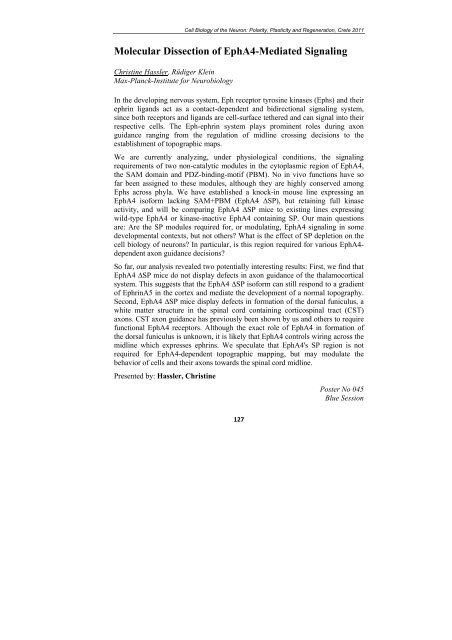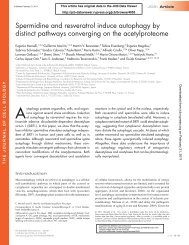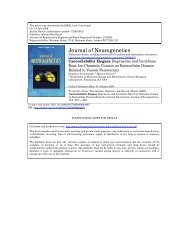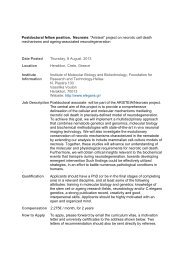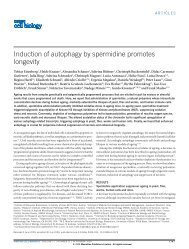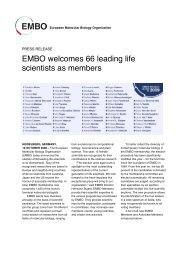CELL BIOLOGY OF THE NEURON Polarity ... - Tavernarakis Lab
CELL BIOLOGY OF THE NEURON Polarity ... - Tavernarakis Lab
CELL BIOLOGY OF THE NEURON Polarity ... - Tavernarakis Lab
Create successful ePaper yourself
Turn your PDF publications into a flip-book with our unique Google optimized e-Paper software.
Cell Biology of the Neuron: <strong>Polarity</strong>, Plasticity and Regeneration, Crete 2011<br />
Molecular Dissection of EphA4-Mediated Signaling<br />
Christine Hassler, Rüdiger Klein<br />
Max-Planck-Institute for Neurobiology<br />
In the developing nervous system, Eph receptor tyrosine kinases (Ephs) and their<br />
ephrin ligands act as a contact-dependent and bidirectional signaling system,<br />
since both receptors and ligands are cell-surface tethered and can signal into their<br />
respective cells. The Eph-ephrin system plays prominent roles during axon<br />
guidance ranging from the regulation of midline crossing decisions to the<br />
establishment of topographic maps.<br />
We are currently analyzing, under physiological conditions, the signaling<br />
requirements of two non-catalytic modules in the cytoplasmic region of EphA4,<br />
the SAM domain and PDZ-binding-motif (PBM). No in vivo functions have so<br />
far been assigned to these modules, although they are highly conserved among<br />
Ephs across phyla. We have established a knock-in mouse line expressing an<br />
EphA4 isoform lacking SAM+PBM (EphA4 ∆SP), but retaining full kinase<br />
activity, and will be comparing EphA4 ∆SP mice to existing lines expressing<br />
wild-type EphA4 or kinase-inactive EphA4 containing SP. Our main questions<br />
are: Are the SP modules required for, or modulating, EphA4 signaling in some<br />
developmental contexts, but not others? What is the effect of SP depletion on the<br />
cell biology of neurons? In particular, is this region required for various EphA4dependent<br />
axon guidance decisions?<br />
So far, our analysis revealed two potentially interesting results: First, we find that<br />
EphA4 ∆SP mice do not display defects in axon guidance of the thalamocortical<br />
system. This suggests that the EphA4 ∆SP isoform can still respond to a gradient<br />
of EphrinA5 in the cortex and mediate the development of a normal topography.<br />
Second, EphA4 ∆SP mice display defects in formation of the dorsal funiculus, a<br />
white matter structure in the spinal cord containing corticospinal tract (CST)<br />
axons. CST axon guidance has previously been shown by us and others to require<br />
functional EphA4 receptors. Although the exact role of EphA4 in formation of<br />
the dorsal funiculus is unknown, it is likely that EphA4 controls wiring across the<br />
midline which expresses ephrins. We speculate that EphA4's SP region is not<br />
required for EphA4-dependent topographic mapping, but may modulate the<br />
behavior of cells and their axons towards the spinal cord midline.<br />
Presented by: Hassler, Christine<br />
127<br />
Poster No 045<br />
Blue Session


